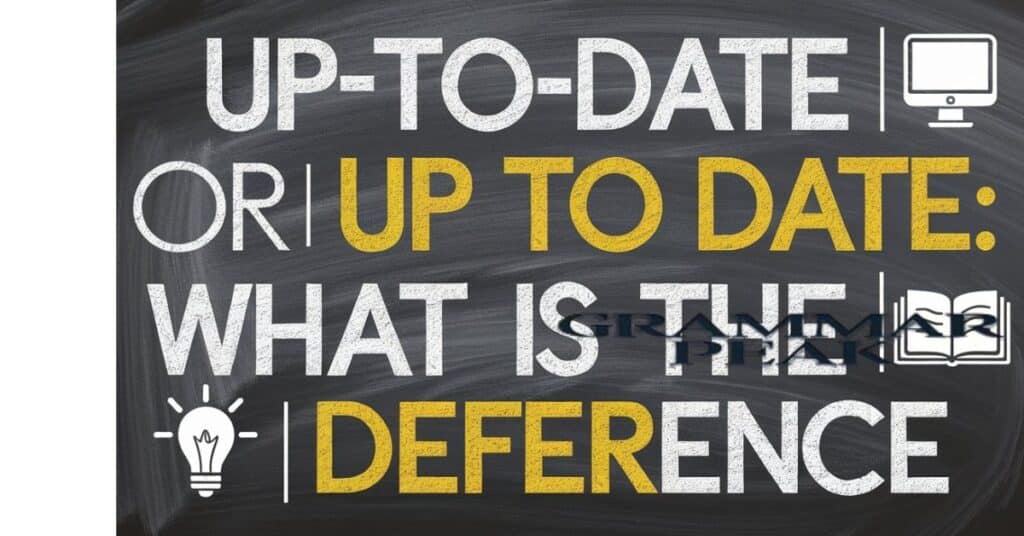“Understanding the subtle differences between phrases like ‘up-to-date’ and ‘up-to-date’ can significantly enhance the clarity of your communication, as knowing when to use ‘up-to-date’ or ‘up-to-date’ correctly ensures your communication remains up-to-date.. Moreover, these phrases, though seemingly similar, hold distinct roles in sentences and convey unique meanings. Consequently, incorporating these nuances into your writing can lead to more effective communication.
Mastering their usage will certainly enhance your English grammar skills. In fact, choosing between these phrases depends on whether you need an adverbial or an adjective phrase. Understanding their proper application ensures your English remains clear and current. For example, Phrases describing the action of updating fit well as adverbs. On the other hand, nouns that are modern or current are best described with adjectives. Therefore, the next time you’re unsure which form to use, remember their roles, and you’ll achieve clarity in your writing.
Why is There Confusion?
One such common quandary revolves around the usage of phrases like ‘up-to-date’ and ‘up-to-date.’ Although they appear similar at first glance, it is important to note that ‘up-to-date’ usage can create a world of difference in conveying accurate meanings. In fact, understanding these ‘up-to-date’ distinctions can significantly enhance your ‘up-to-date’ communication skills.
“The subtle differences in how ‘up-to-date’ phrases are used in sentences are often a source of confusion. The distinction lies in their grammatical roles: one functions as an adverbial phrase, while the other serves as an adjective phrase. Despite their similar appearance, these phrases have different applications, and misunderstanding them can cause ambiguity. Therefore, understanding these differences is essential for clear and effective communication.”
The fog of confusion is dispelled by understanding the context of the sentence in which these phrases are used. Recognizing whether the sentence calls for an adverb or an adjective can guide you in choosing between “Up to Date” and “Up-to-Date.” In particular, this understanding is essential because it helps clarify the intended meaning. Consequently, making the right choice can significantly improve the effectiveness of your communication. By mastering this, you can navigate the intricate maze of the English language with greater ease.
You will might Up to Date or Up-to-Date: Which One Should You Use?
What Does “Up to Date” Mean?
As an adverbial phrase, ‘up-to-date’ expresses the action of maintaining currency or relevancy in a given context. ‘Up-to-date’ paints a picture of something being in line with the latest developments or trends, ensuring that it holds the most recent ‘up-to-date’ information.”
“For example, if you maintain a blog and ensure that all the content reflects current trends or information, you are keeping your blog updated. Similarly, if a teacher revises her teaching materials to include the latest research or advancements, she is keeping her syllabus current. Thus, staying updated signifies the process of adapting to remain relevant with changing times. This practice is crucial for effectively engaging your audience.”
What Does “Up-to-Date” Mean?
“This hyphenated term, ‘up-to-date,’ serves as an adjective, attributing the quality of being current, modern, or having the latest information to the noun it modifies. The hyphen connects the words into a single modifier describing a noun. For example, consider a computer equipped with the latest operating system and advanced technology. This combination not only boosts performance but also ensures compatibility with the newest applications.”
“As a result, users can achieve better efficiency and functionality by staying current, which is vital in today’s fast-paced digital world. Furthermore, keeping up with technological advancements is not just a luxury but a necessity for maintaining performance and security. Therefore, regular updates to both hardware and software are essential for users seeking to optimize their computing experience.”
Explore these Up to Date or Up-to-Date: Which One Should You Use?
“Up to Date” vs “Up-to-Date”
“An action is described using ‘up-to-date’ as an adverbial phrase, while a noun is described using it as an adjective phrase. This distinction emphasizes the different grammatical roles these phrases play. Understanding these roles is essential for clear communication and avoiding potential misunderstandings.”
“The use of a hyphen in ‘up-to-date’ signifies its role as a single descriptive entity, while the absence of a hyphen indicates its function as a phrase describing an action. This distinction is important as it clarifies grammatical roles and prevents confusion, ultimately improving your writing.”
When to Use “Up to Date”
“The process of maintaining something with the most recent information is referred to as being ‘current’ or ‘updated.'”
For example, “I keep my calendar updated with all my appointments. This practice helps me stay organized and ensures I never miss important events. As a result, I can manage my time effectively and maintain a balanced schedule.”
When to Use “Up-to-Date”
“Something that contains the most recent information is referred to as ‘current’ or ‘updated.'”
The Importance of Context
“Contextual writing is essential when choosing how to use ‘up-to-date.’ Using it correctly improves clarity and keeps your writing current.”
The context of the sentence and the role the phrase plays in the sentence (either as an adverb or an adjective) will determine which phrase to use.
| Aspect | “Up to Date” | “Up-to-Date” |
| Part of Speech | Prepositional phrase | Compound adjective |
| Function | Indicates the process or action of updating | Indicates the state of being current or modern |
| Hyphenation | No hyphens | Hyphenated |
| Example Sentence | “We need to get our software up to date.” | “Our up-to-date software has the latest features.” |
| Usage | Often used with verbs indicating an action or change | Used to describe nouns that are modern or current |
| Position in Sentence | Typically used at the end of a sentence or clause | Generally used before the noun it modifies |
Synonyms for “Up to Date” and “Up-to-Date”
Synonyms for “Up to Date” (Adverbial Phrase)
- Modern: Reflects the latest style or design.
- Example: To attract potential buyers, a modern style needs to be maintained in the interior design of the house.
- Contemporary: Reflects the style or trend of the present time.
- Example: “The artist tries to keep his work contemporary to engage a wider audience.”
- Updated: Reflects the state of having the latest information.
- Example: “It’s crucial to keep the antivirus software updated to protect against the latest threats.”
- Advanced: Reflects the state of being progressive or ahead in terms of technology or ideas.
- Example: “To stay competitive in the market, we need to keep our technology advanced.”
- Latest: Reflects the most recent information, data, or trends.
- Example: “We need to keep abreast of the latest news in our industry.”
- Fresh: Reflects the state of being new or recent.
- Example: “The chef always keeps the menu fresh to provide a unique dining experience.”
- Innovative: Reflects the state of introducing new ideas or methods.
- Example: “To keep our business model innovative, we constantly explore new strategies.”
- Progressive: Reflects the state of making progress towards better conditions.
- Example: To effectively educate the students, a progressive approach needs to be maintained in our teaching methods.
- Newest: Reflects the very latest or most recent.
- Example: “To maintain high traffic, the blogger needs to keep his content the newest.”
- Cutting-edge: Reflects the state of being at the forefront of development or technology.
- Example: “To retain its market position, the company must keep its products cutting-edge.”
Synonyms for “Up-to-Date” (Adjective Phrase)
- Current: It is implied that something is happening or being used now.
- Example: “The current version of the software is very efficient.”
- Contemporary: Suggests that something is of the same age; existing or occurring in the same period of time.
- Example: “The gallery showcases contemporary artwork.”
- Latest: Suggests that something is the most recent or the newest.
- Example: “She always has the latest fashion accessories.”
- Advanced: Suggests that something is further along in progress, complexity, or development.
- Example: “They have the most advanced machinery in the industry.”
- Updated: It is suggested that something has been improved, or that information in it has been altered to be more accurate or relevant.
- Example: “The updated policy now includes provisions for remote work.”
- Fresh: Suggests that something is new or different.
- Example: “The magazine always features fresh content.”
- Innovative: Suggests that something features new ideas, methods, or products.
- Example: The innovative designs are known to be associated with the company.
- Progressive: Suggests that something is continually advancing or improving.
- Example: “The firm has a progressive approach to employee benefits.”
- Newest: Suggests that something is the latest addition or development.
- Example: “The newest model of the car has improved safety features.”
- Cutting-edge: Suggests that something is at the leading edge of technology or trends.
- Example: Cutting-edge equipment is used to equip the laboratory.
Choosing the Right Synonym
“Selecting the appropriate synonym for ‘up-to-date’ depends on the context of the sentence and the specific nuance you wish to convey.”
It’s important to consider the adjective vs. adverb distinction and the specific connotations of each synonym.
Examples in Context
Examples Using “Up to Date” (Adverbial Phrase)
- “He consistently ensures the server systems are updated to optimize network security, maintaining a current infrastructure for protection.”
- “She consistently updates her design portfolio to showcase her latest works, ensuring it remains relevant and current.”
- “She regularly updates her methodologies to align her data analysis with current industry standards, ensuring it remains effective.”
- “He ensures the employee handbook is regularly updated with current company policies, maintaining its relevance and accuracy.”
- “She ensures the product listings are regularly updated with current availability and pricing, keeping everything accurate for customers.”
- “The news editor diligently updates the website with breaking news and current affairs, ensuring it remains relevant for readers.”
- “He ensures the app is updated with the latest mobile operating system updates, maintaining its compatibility and functionality.”
- “She ensures her vehicle designs meet the latest safety and efficiency standards, keeping them aligned with industry requirements.”
Examples Using “Up-to-Date” (Adjective Phrase)
- “He checks the latest weather forecast before starting his expeditions, ensuring he is informed about current conditions.”
- “He relies on current market data when making investment decisions, ensuring his choices are informed by the latest information and trends.”
- “She uses modern teaching materials to ensure her students receive the most current information, keeping their education relevant and timely.”
- “He adheres to a modern workout regimen informed by the latest fitness research.”
- “She performs her experiments using modern laboratory equipment.”
- “He keeps a current database to ensure optimal system performance.”
- “She incorporates current references in her books to ensure they are relevant and informative.”
- “She uses advanced software to design innovative and efficient structures.”
Origins of “Up to Date” and “Up-to-Date”
.
Origins of “Up to Date”
The term initially described something current or in line with the present time. People often associated it with the rapid development of technology and the increasing pace of life during the Industrial Revolution.
The phrase was employed to highlight the importance of keeping up with the times, staying informed, and adapting to changes. Its versatility stands out, as various industries and professions can apply it in different contexts.
Origins of “Up-to-Date”
Its usage was primarily to denote something current or modern, particularly in the context of technology, fashion, or trends.
The phrase was a reflection of the rapid advancements and changes that were occurring during the Industrial Revolution, a time when it was increasingly important to stay abreast of new developments. Across various fields, from technology to medicine to education, it now symbolizes the importance of staying current and informed in our ever-evolving world.
FAQ” S
What is the difference between “Up to Date” and “Up-to-Date”?
“Up to Date” is an adverbial phrase, while “Up-to-Date” is an adjective phrase.
When should I use “Up to Date”?
Use “Up to Date” to describe the act of keeping something current or updated.
When should I use “Up-to-Date”?
Use “Up-to-Date” to describe something that is current or contains the most recent information.
What role does context play in choosing between “Up to Date” and “Up-to-Date”?
The context of the sentence and the role the phrase plays (as an adverb or adjective) determine which phrase to use.
Are there synonyms for “Up to Date” and “Up-to-Date”?
Yes, synonyms like “current”, “modern”, “contemporary”, and “latest” can be interchanged depending on context.
Conclusion
Understanding the difference between “Up to Date” and “Up-to-Date” can enhance your writing precision and grammar in digital communication. By considering the context in writing and the adjective vs. adverb distinction, you can choose the right phrase to convey your message clearly and effectively. Remember, proper grammar usage and writing clarity are key to effective communication.

Mason Blake is an experienced blogger with a passion for language and communication. With years of expertise in crafting informative and engaging content, Mason shares valuable insights on grammar and writing. His clear, concise, and reader-friendly approach has earned him a loyal following, helping readers sharpen their language skills and master the art of effective communication.








Can you be more specific about the content of your article? After reading it, I still have some doubts. Hope you can help me.
Your article helped me a lot, is there any more related content? Thanks!
Thanks for sharing. I read many of your blog posts, cool, your blog is very good.
Your point of view caught my eye and was very interesting. Thanks. I have a question for you.